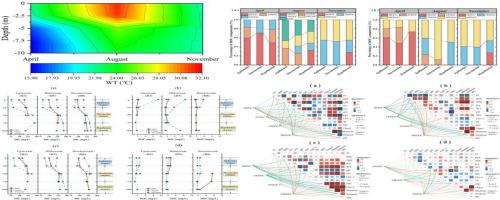亚热带周期性层状储层热分层期高固碳:MCP驱动下RDOC转化效率的证据
IF 12.4
1区 环境科学与生态学
Q1 ENGINEERING, ENVIRONMENTAL
引用次数: 0
摘要
微生物碳泵(MCP)产生的顽固性溶解有机碳(RDOC)显著影响陆地水体,并可能有助于形成持久的碳汇。然而,对于亚热带热结构变化对MCP固碳过程和效率的响应研究还很缺乏。本文研究了亚热带典型储层大龙洞(DLD)储层在热分层(TS)期和混合(MX)期不同水深下MCP对溶解无机碳(DIC)转化为溶解有机碳(DOC)再转化为RDOC的影响。结果表明,微生物难溶性有机碳(MRDOC)的转化效率在TS时期通常是MX时期的4倍。这种增加可归因于参与固碳的细菌的丰度增加,以及外部半不稳定溶解有机碳(SLDOC)和不稳定溶解有机碳(LDOC)水平的提高,以及有机质的积累。在明显热分层(OTS)期间,温跃层的转换效率达到峰值。在TS时期,异养细菌和化养自养细菌在表层和温跃层的固碳作用显著,而在表层和温跃层的固碳作用较少。相反,在整个MX期,水温和pH的影响导致自养细菌在固碳中的作用减弱,导致各水层MRDOC转化效率下降。这些结果增强了我们对经历热结构变化的陆地水体中MCP效应影响的碳循环过程的认识。本文章由计算机程序翻译,如有差异,请以英文原文为准。


High carbon fixation during thermal stratification period in a subtropical periodic stratified reservoir: Evidences from RDOC conversion efficiency driven by MCP
Recalcitrant dissolved organic carbon (RDOC) generated by microbial carbon pumps (MCP) significantly influences terrestrial waters and may contribute to the formation of a long-lasting carbon sink. However, there remains a notable lack of research on the carbon fixation processes and efficiencies of MCP in response to changes in thermal structure within subtropical reservoirs. In this study, we examined the effectiveness of transforming dissolved inorganic carbon (DIC) into dissolved organic carbon (DOC) and subsequently into RDOC through the influence of MCP at various water depths during both Thermal stratification (TS) periods and Mixing (MX) period in the Dalongdong (DLD) Reservoir, a representative subtropical reservoir. The findings indicate that the conversion efficiency of microbiologically recalcitrant dissolved organic carbon (MRDOC) was typically four times greater during the TS periods compared to the MX period. This increase can be attributed to a higher abundance of bacteria involved in carbon fixation, as well as elevated levels of external semi-labile dissolved organic carbon (SLDOC) and labile dissolved organic carbon (LDOC), along with the accumulation of organic matter. Notably, the conversion efficiency peaked in the thermocline during the Obvious thermal stratification (OTS) period. During the TS periods, heterotrophic and chemoautotrophic bacteria played a significant role in carbon fixation in the epilimnion and thermocline, while fewer bacteria were engaged in carbon fixation in the hypolimnion. Conversely, throughout the MX period, the effects of water temperature and pH result in a diminished role of autotrophic bacteria in carbon fixation, leading to a decline in MRDOC conversion efficiency at all water layers. These results enhance our understanding of the carbon cycling processes influenced by the MCP effect in terrestrial waters experiencing changes in thermal stratification.
求助全文
通过发布文献求助,成功后即可免费获取论文全文。
去求助
来源期刊

Water Research
环境科学-工程:环境
CiteScore
20.80
自引率
9.40%
发文量
1307
审稿时长
38 days
期刊介绍:
Water Research, along with its open access companion journal Water Research X, serves as a platform for publishing original research papers covering various aspects of the science and technology related to the anthropogenic water cycle, water quality, and its management worldwide. The audience targeted by the journal comprises biologists, chemical engineers, chemists, civil engineers, environmental engineers, limnologists, and microbiologists. The scope of the journal include:
•Treatment processes for water and wastewaters (municipal, agricultural, industrial, and on-site treatment), including resource recovery and residuals management;
•Urban hydrology including sewer systems, stormwater management, and green infrastructure;
•Drinking water treatment and distribution;
•Potable and non-potable water reuse;
•Sanitation, public health, and risk assessment;
•Anaerobic digestion, solid and hazardous waste management, including source characterization and the effects and control of leachates and gaseous emissions;
•Contaminants (chemical, microbial, anthropogenic particles such as nanoparticles or microplastics) and related water quality sensing, monitoring, fate, and assessment;
•Anthropogenic impacts on inland, tidal, coastal and urban waters, focusing on surface and ground waters, and point and non-point sources of pollution;
•Environmental restoration, linked to surface water, groundwater and groundwater remediation;
•Analysis of the interfaces between sediments and water, and between water and atmosphere, focusing specifically on anthropogenic impacts;
•Mathematical modelling, systems analysis, machine learning, and beneficial use of big data related to the anthropogenic water cycle;
•Socio-economic, policy, and regulations studies.
 求助内容:
求助内容: 应助结果提醒方式:
应助结果提醒方式:


